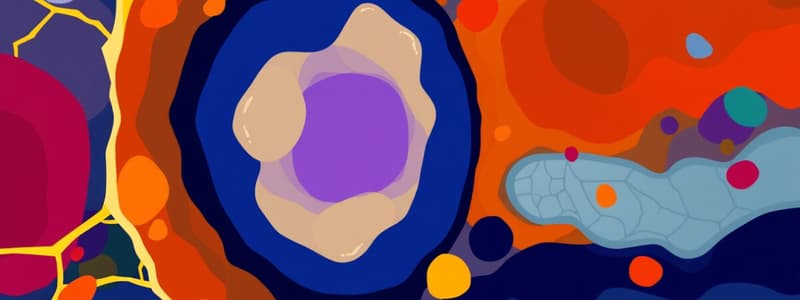Podcast
Questions and Answers
What are the three main regions of a generalized cell?
What are the three main regions of a generalized cell?
Nucleus, Plasma Membrane, Cytoplasm
What is the control center of a cell called?
What is the control center of a cell called?
Nucleus
The nuclear membrane encloses a jellylike fluid called _____
The nuclear membrane encloses a jellylike fluid called _____
nucleoplasm
What are nucleoli responsible for?
What are nucleoli responsible for?
Which of the following materials are found in the plasma membrane? (Select all that apply)
Which of the following materials are found in the plasma membrane? (Select all that apply)
Match the types of membrane junctions with their functions:
Match the types of membrane junctions with their functions:
What is cytosol?
What is cytosol?
What are inclusions in the context of cytoplasm?
What are inclusions in the context of cytoplasm?
What term is used to describe specialized compartments within a cell?
What term is used to describe specialized compartments within a cell?
Flashcards are hidden until you start studying
Study Notes
Cells Overview
- Cells are the fundamental units of all living organisms, providing structure, nutrient intake, energy conversion, and specialized functions.
- A generalized cell consists of three main regions: nucleus, plasma membrane, and cytoplasm.
Nucleus
- Acts as the control center of the cell, housing genetic material (DNA).
- Three important regions within the nucleus:
- Nucleolus: Produces ribosomes.
- Chromatin: DNA in its uncoiled form.
- Nuclear Membrane: Double-layered barrier that protects the nucleus, featuring nuclear pores for material exchange.
- The jelly-like fluid inside the nucleus is known as nucleoplasm.
Plasma Membrane
- A semi-permeable barrier that separates cell contents from the environment, maintaining homeostasis.
- Composed of a double layer of phospholipids: hydrophilic heads attract water while hydrophobic tails repel it.
- Contains:
- Proteins: Engage in transport, recognition, and communication.
- Cholesterol: Stabilizes membrane fluidity.
- Glycoproteins: Mediate cell interactions and recognition.
Membrane Junctions
- Tight Junctions: Form impermeable connections to create leakproof sheets.
- Desmosomes: Anchor cells together, providing structural stability under stress.
- Gap Junctions: Allow communication between adjacent cells through channels known as connexons.
Cytoplasm
- The material within the cell, lying between the nucleus and the plasma membrane, often referred to as the “factory area.”
- Comprises three major elements:
- Cytosol: Fluid component where nutrients are dissolved and other components are suspended.
- Organelles: Specialized structures (“little organs”) that perform various cellular functions.
- Inclusions: Storage units that hold nutrients like fat droplets and glycogen.
Cytoplasmic Organelles
- Each organelle serves specific functions vital for cell maintenance and processes.
- These include structures responsible for energy production, protein synthesis, and waste processing.
Cell Diversity
- Refers to the variety of cell types and their specialized functions in multicellular organisms.
- Specialized cells adapt to perform specific tasks, maintaining the organism's overall function.
Solutions and Transport
- Understanding cellular transport mechanisms is crucial for comprehension of how substances move across cell membranes.
- Includes passive and active transport methods that facilitate nutrient uptake and waste removal.
These notes encapsulate the essential aspects of cells and tissues, providing a concise overview of cellular structure and function.
Studying That Suits You
Use AI to generate personalized quizzes and flashcards to suit your learning preferences.




